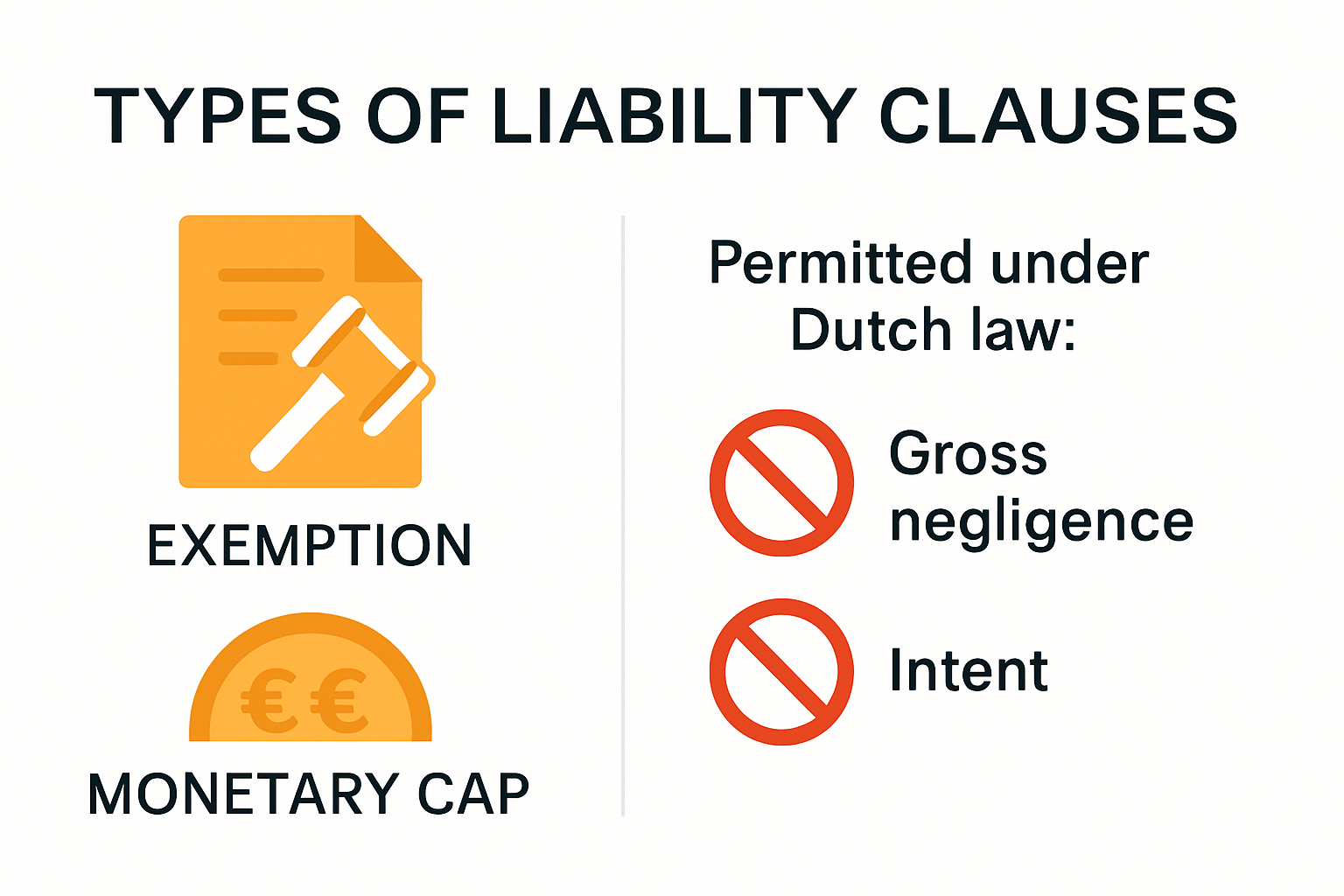Limiting liability in business contracts always feels like walking a tightrope. Dutch law actually lets parties set liability caps as high as 100 percent of a contract’s value or a fixed sum like €500,000. Most people expect airtight liability shields to work every time. But those shields can fall apart in court if they edge into unfairness or try to excuse gross negligence. That flips the whole game on its head.
Table of Contents
Quick Summary
| Takeaway | Explanation |
| Understand limitation of liability principles | Familiarise yourself with the legal boundaries and expectations for limiting liability in contracts in the Netherlands. |
| Use precise contractual language | Clearly define liability limitations in contracts to avoid ambiguity, ensuring enforceability and protection against unreasonable clauses. |
| Conduct thorough risk assessments | Regularly evaluate potential liabilities specific to your business to develop informed risk management and insurance strategies. |
| Be aware of industry-specific considerations | Different sectors have unique liability profiles; stay informed about applicable standards to navigate these complexities effectively. |
| Consult legal professionals for guidance | Seeking expert legal advice helps tailor your liability strategies to ensure compliance and mitigate risks effectively. |
Key Principles of Limitation of Liability in the Netherlands
Limitation of liability represents a critical legal mechanism in Dutch contract law that allows parties to define and manage potential financial risks. Understanding the nuanced framework of liability limitations protects businesses and individuals from potentially catastrophic financial consequences.
Fundamental Legal Boundaries
Dutch contract law provides a flexible yet structured approach to limiting liability. The core principle revolves around parties’ autonomy to negotiate contractual terms, balanced against protecting fundamental legal rights. Not all liability can be excluded, creating a delicate legal landscape where strategic drafting becomes paramount.
Parties can generally limit their liability through explicit contractual provisions. However, certain absolute restrictions exist. Liability cannot be completely eliminated for intentional misconduct (opzet) or situations involving gross negligence (bewuste roekeloosheid). This means that while you can reduce potential financial exposure, you cannot create a total shield against egregious actions or deliberate harm.
Contractual Strategies for Risk Management
In practice, Dutch businesses employ several sophisticated strategies to manage liability risks. Common approaches include setting aggregate caps, establishing annual liability limits, and defining fixed monetary thresholds. These mechanisms allow parties to quantify potential financial exposure in advance, providing clarity and predictability.
Typical liability caps might be structured as a percentage of total contract value or a fixed monetary amount. For instance, a contract might limit liability to 100% of the total contract sum or a predetermined fixed amount like €500,000. The specific approach depends on the nature of the transaction, risk profile, and negotiating power of involved parties.
Legal Limitations and Public Policy Considerations
Dutch legal framework maintains strong public policy protections that prevent unreasonable liability exclusions. Courts will carefully scrutinize liability clauses to ensure they do not create fundamentally unfair contractual conditions. If a limitation appears excessively restrictive or undermines the core purpose of an agreement, judicial intervention becomes possible.
Critical factors courts consider include the relationship between parties, relative bargaining power, transparency of the limitation clause, and potential consequences of total exclusion. This approach ensures that limitation of liability remains a tool for reasonable risk management rather than a mechanism for potential abuse.
For businesses seeking comprehensive protection, understanding these principles is crucial. Learn more about navigating liability risks with expert legal guidance tailored to your specific circumstances. Professional legal consultation can help craft robust liability strategies that balance protection and fairness.
Common Clauses and Their Legal Boundaries
In the complex landscape of Dutch contract law, certain liability limitation clauses emerge as standard practice, each with unique legal implications and strategic considerations. Understanding these common clauses provides businesses and individuals with critical insights into managing contractual risks effectively.
Exemption and Exclusion Clauses
Exemption clauses represent a fundamental mechanism for managing potential legal exposure. These contractual provisions allow parties to define specific scenarios where liability will not apply. However, Dutch law maintains strict boundaries around such clauses to prevent potential abuse.
Typically, exemption clauses might exclude liability for indirect damages, consequential losses, or specific types of performance failures. While parties can negotiate these terms, courts will carefully examine their fairness and reasonableness. Critically, no exemption clause can shield a party from liability arising from intentional misconduct or gross negligence. This ensures that fundamental principles of good faith and reasonable conduct remain protected.
The following table summarises the main types of liability limitation clauses used in Dutch business contracts, along with their key features and legal boundaries:
| Clause Type | Typical Use Case | Legal Boundaries |
| Exemption/Exclusion | Excluding liability for certain types of losses | Cannot exclude intentional misconduct or gross negligence |
| Monetary Cap | Limiting financial liability to a set amount | Often set as a contract % (e.g., 100%) or fixed sum (e.g., €500,000) |
| Annual/Aggregate Limit | Setting limits per year or contract term | Courts scrutinise fairness and transparency |
| Indirect Loss Exclusion | Excluding liability for consequential damages | Courts review reasonableness and clarity |
Monetary Limitation and Cap Strategies
Monetary limitation clauses provide another sophisticated approach to managing contractual risk. These provisions typically establish a predetermined financial threshold beyond which a party cannot be held liable. Common strategies include setting liability caps as a percentage of total contract value or establishing fixed monetary limits.
For instance, a contract might stipulate that total liability is capped at 100% of the contract sum or a specific amount like €250,000. The precise structure depends on various factors including transaction complexity, industry standards, and relative negotiating power of involved parties. Explore comprehensive guidance on crafting robust contract terms to understand how these strategies can be effectively implemented.
Nuanced Legal Interpretation and Enforcement
Dutch courts approach liability limitation clauses with a nuanced perspective, balancing contractual freedom with fundamental principles of fairness. While parties have significant autonomy in drafting these provisions, judicial review remains a critical safeguard against potentially exploitative terms.

Key considerations in evaluating liability clauses include the relationship between contracting parties, their relative bargaining positions, transparency of the clause, and potential economic consequences. A limitation that might be acceptable between sophisticated commercial entities could be deemed unreasonable in consumer contracts.
Businesses must therefore craft liability limitation clauses with precision, understanding that overly broad or opaque provisions risk being deemed unenforceable. Professional legal consultation becomes crucial in navigating these complex contractual waters, ensuring that risk management strategies remain both effective and legally sound.
Practical Tips for Individuals and Businesses
Navigating liability limitations requires strategic planning and meticulous attention to detail. Whether you are an individual entrepreneur or a large corporate entity, understanding how to effectively manage potential legal risks can protect your financial interests and prevent costly disputes.
Strategic Contract Drafting
Careful contract drafting represents the first line of defense in managing liability exposure. Businesses must approach contractual provisions with precision, ensuring that limitation clauses are clear, specific, and legally enforceable. This involves creating comprehensive definitions of potential risks, explicitly stating scenarios where liability might be limited or excluded.
Key considerations include identifying potential performance failures, quantifying financial risks, and establishing transparent mechanisms for addressing potential disputes. Smart entrepreneurs will invest time in developing robust contractual language that balances protection with fairness. Remember that overly aggressive liability limitations can themselves become legally problematic if they appear unreasonable or designed to circumvent fundamental contractual obligations.
Risk Assessment and Insurance Strategies
Comprehensive risk management extends beyond contractual provisions. Businesses should conduct thorough risk assessments that map potential liability scenarios across different operational contexts. This involves analyzing historical performance data, industry-specific risks, and potential economic consequences of various liability events.
Professional liability insurance plays a critical role in this strategy. Tailored insurance products can provide additional financial protection, supplementing contractual liability limitations. The goal is creating a multi-layered approach where contractual provisions and insurance coverage work in concert to mitigate potential financial exposure. Learn more about developing comprehensive business protection strategies that integrate legal and financial risk management techniques.
Documentation and Compliance Protocols
Maintaining meticulous documentation represents another crucial aspect of effective liability management. Businesses must establish robust internal protocols for recording communication, tracking performance metrics, and documenting potential risk events. Clear, contemporaneous documentation can provide critical evidence in case of potential legal disputes.

Below is a checklist table outlining practical steps and considerations for effectively managing liability limitations, as discussed in the article:
| Action Step | Key Consideration | Status/Importance |
| Careful Contract Drafting | Ensure clauses are precise and transparent | Essential |
| Regular Risk Assessments | Identify and quantify potential liabilities | Crucial |
| Obtain Professional Legal Consultation | Tailor strategies to specific risks and laws | Highly Recommended |
| Arrange Liability Insurance | Provide extra protection beyond contractual caps | Strongly Advised |
| Maintain Robust Documentation | Record communications and potential risk events | Important for dispute resolution |
This approach requires developing systematic record-keeping processes that capture relevant information comprehensively yet efficiently. Digital documentation systems, standardized reporting templates, and clear communication guidelines can help organizations maintain the level of transparency necessary to support potential liability limitation claims.
Ultimately, managing liability limitations is not about creating impenetrable legal shields but developing nuanced, balanced approaches that protect legitimate business interests while maintaining fundamental principles of fairness and good faith. Professional legal consultation remains essential in crafting strategies tailored to your specific operational context and risk profile.
Risks and Exceptions to Be Aware Of
Navigating liability limitations requires a deep understanding of potential risks and critical legal exceptions that can fundamentally alter contractual protections. Dutch law provides a sophisticated framework that balances contractual freedom with essential protections against potential abuse.
Absolute Liability Exclusions
Certain scenarios exist where liability limitations become legally unenforceable, regardless of contractual language. Intentional misconduct and gross negligence represent absolute exceptions where parties cannot contract away their fundamental legal responsibilities. This means that no matter how carefully drafted a limitation clause might be, actions demonstrating deliberate harm or extreme recklessness will remain fully actionable.
The legal principle underlying these exceptions ensures that contractual provisions cannot be used as shields for fundamentally unethical or dangerous behavior. Courts maintain the power to invalidate any clause attempting to eliminate liability for actions that represent a serious breach of professional or personal duty. Businesses and individuals must understand that good faith and reasonable conduct are non-negotiable legal standards.
Industry-Specific Liability Considerations
Different sectors introduce unique liability risk profiles that require nuanced understanding. Construction, technology, healthcare, and financial services each present distinct challenges in managing potential legal exposure. For instance, professional service industries often face more stringent liability standards due to the potential for significant consequential damages.
Some industries have established standard contract terms that provide default liability frameworks. These industry-specific guidelines often reflect accumulated legal experience and represent a balanced approach to risk management. Professionals must stay attuned to sector-specific regulations and standard practices that might limit or modify general liability principles.
Emerging Legal and Technological Risks
Technological advancements and evolving business models continuously challenge traditional liability frameworks. Digital platforms, artificial intelligence applications, and complex international transactions create novel scenarios where traditional liability limitation strategies might prove insufficient. Explore comprehensive insights into modern compliance challenges to understand how emerging technologies reshape legal risk management.
Cybersecurity risks, data protection violations, and cross-border transaction complexities represent critical areas where standard liability limitations may require sophisticated, forward-looking approaches. Businesses must develop dynamic risk management strategies that anticipate potential legal challenges rather than merely reacting to existing frameworks.
Ultimately, effective liability management demands a proactive, holistic approach. While contractual provisions provide essential protection, they cannot replace comprehensive risk assessment, robust internal controls, and a fundamental commitment to ethical business practices. Professional legal consultation remains crucial in developing nuanced strategies that balance protection with responsible conduct.
Frequently Asked Questions
What are the limitations of liability under Dutch law?
Dutch law allows parties to limit liability typically up to 100% of a contract’s value or a fixed sum such as €500,000. However, liability cannot be excluded for intentional misconduct or gross negligence.
Can liability limitations be enforced in court?
Yes, liability limitations can be enforced in court, but they must be clearly defined and reasonable. Courts will scrutinise clauses to ensure they do not create fundamentally unfair conditions.
What types of clauses can be used to limit liability in contracts?
Common clauses to limit liability include exemption and exclusion clauses, monetary caps, and annual or aggregate limits. Each has specific legal boundaries that must be adhered to.
How can businesses effectively manage liability risks?
Businesses can manage liability risks through strategic contract drafting, conducting thorough risk assessments, obtaining appropriate insurance coverage, and maintaining meticulous documentation of all contractual relationships.
Transform Uncertainty into Confidence: Tackle Limitation of Liability with Law & More
Drawing on the crucial points from this article, you may be facing the worry that your liability clauses will not stand up in a Dutch court. Many contracts seem secure at first, yet terms can unravel quickly if not drafted with care. The risk of unfairness or ambiguity in limitation of liability agreements can put your business or personal assets at stake. When Dutch law scrutinises concepts such as caps on damages, exemption clauses, and the enforceability of liability limitations, only tailored legal support can give you true peace of mind.
You do not have to handle these risks alone
If you want to ensure your limitation of liability clauses are sound and futureproof, speak with our legal experts. You will benefit from clear guidance, multilingual support, and industry-specific solutions designed for your contract. Act today to avoid costly surprises and build a solid legal foundation for your business. Visit Law & More now to book your consultation or explore our expertise in liability and damages claims.
